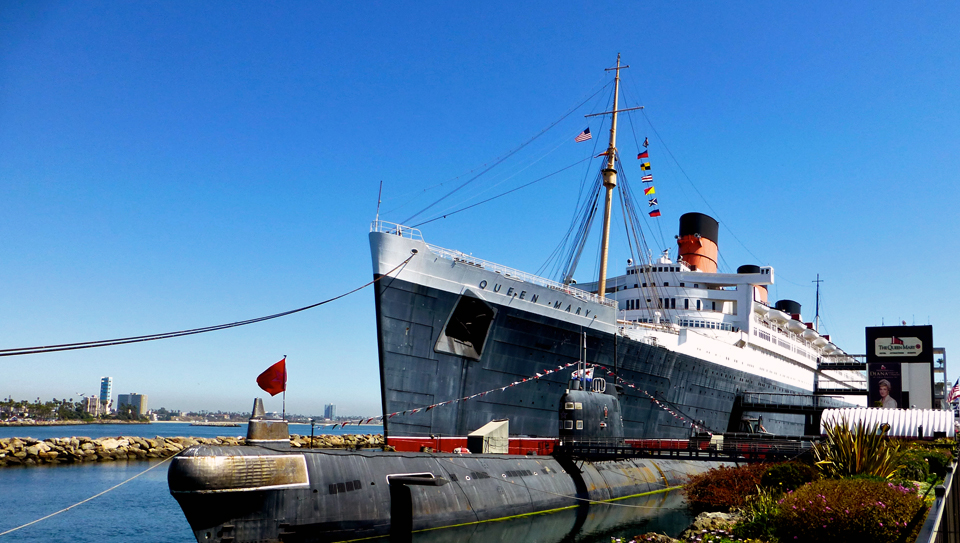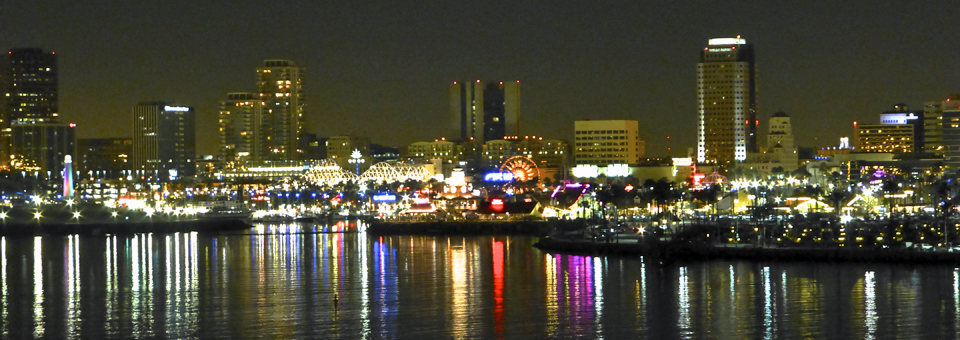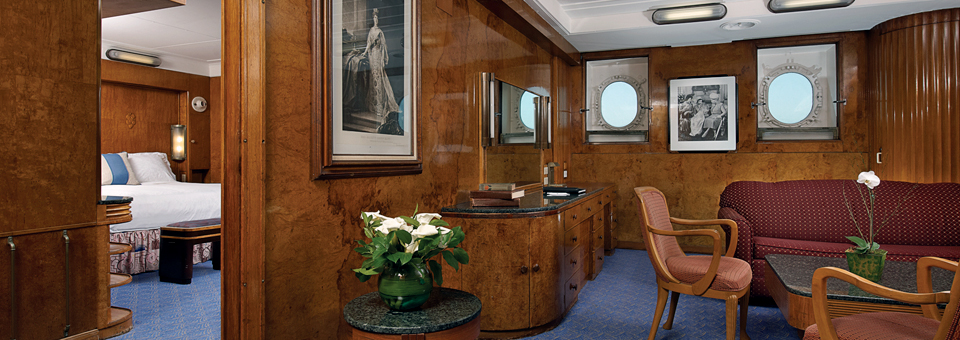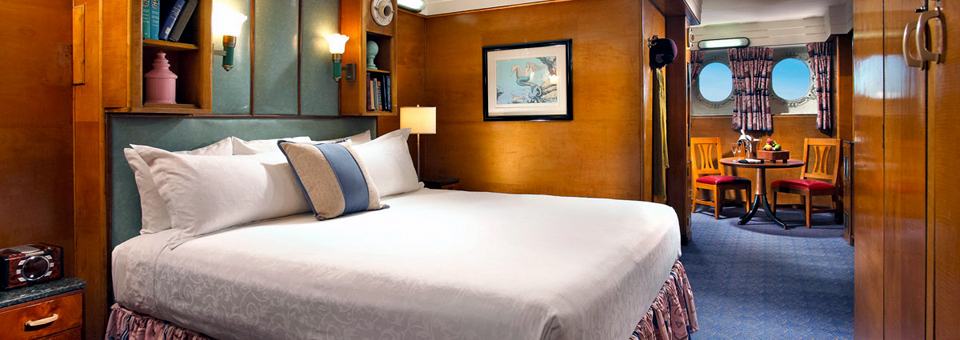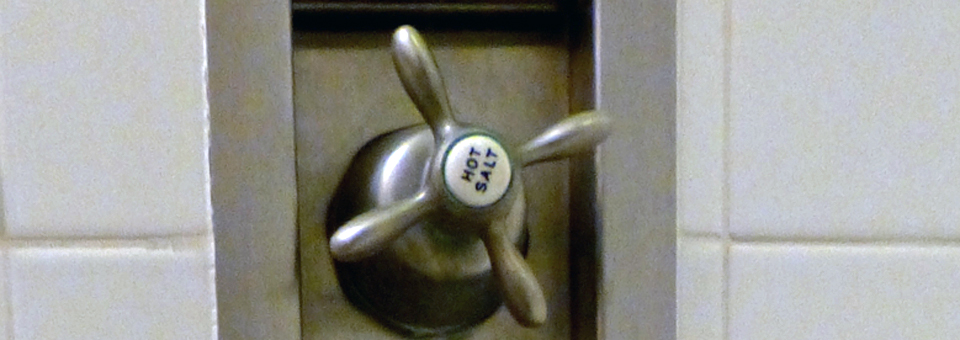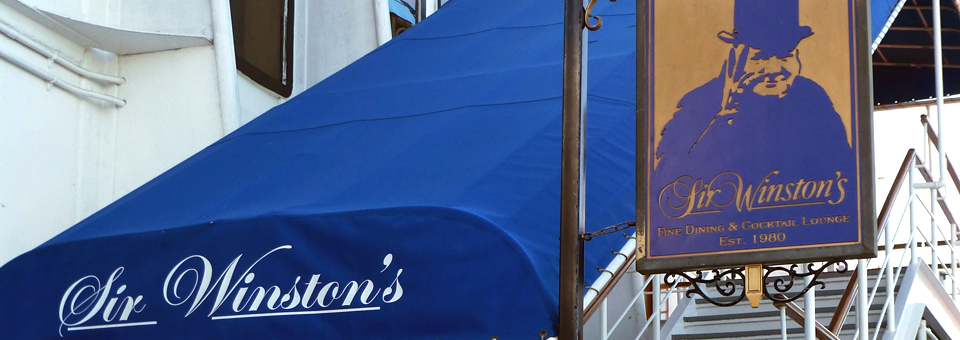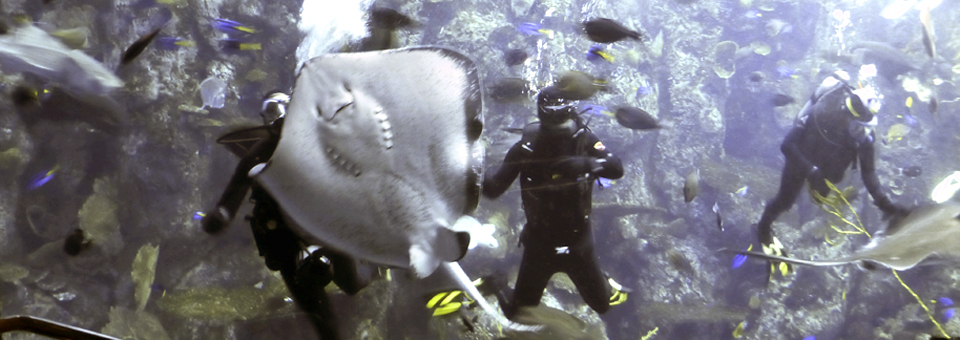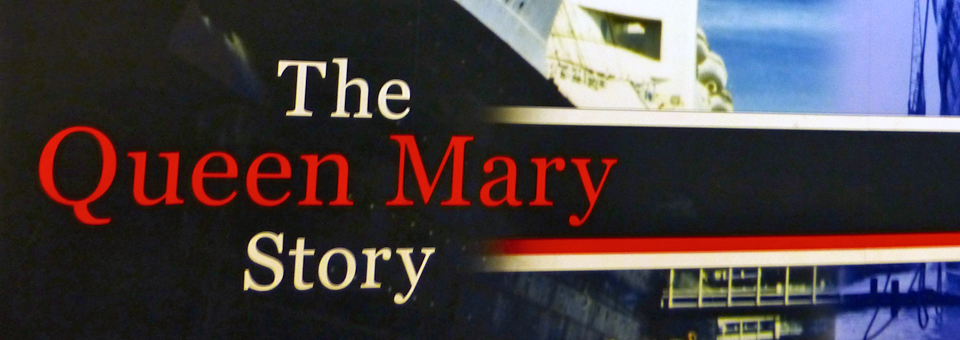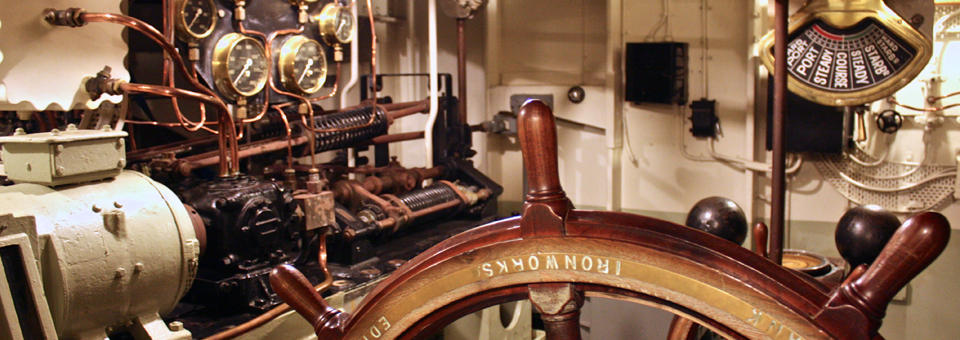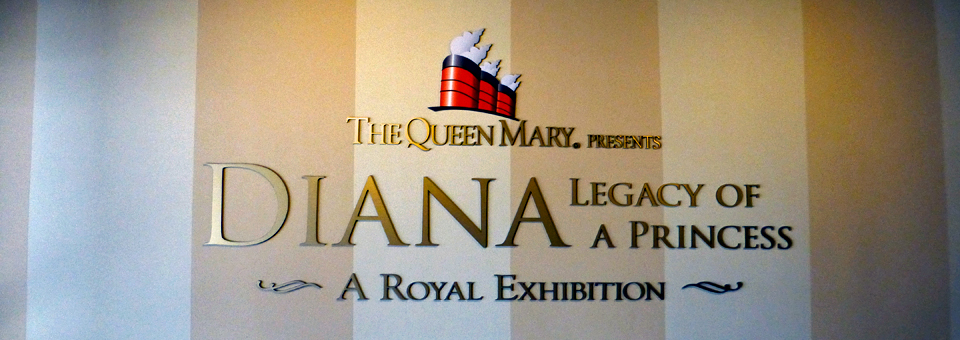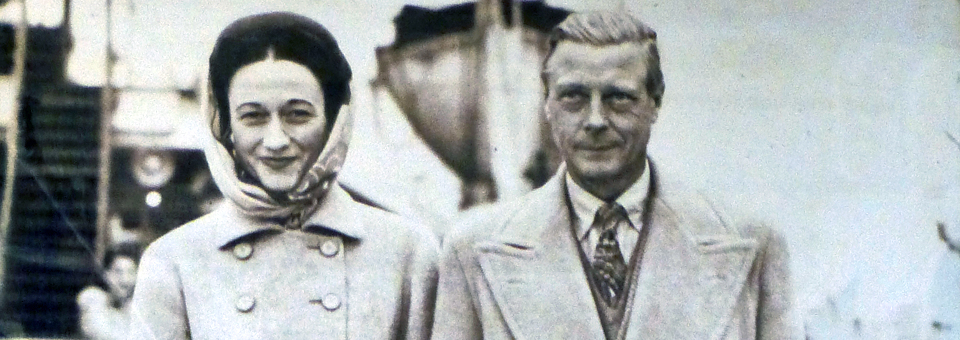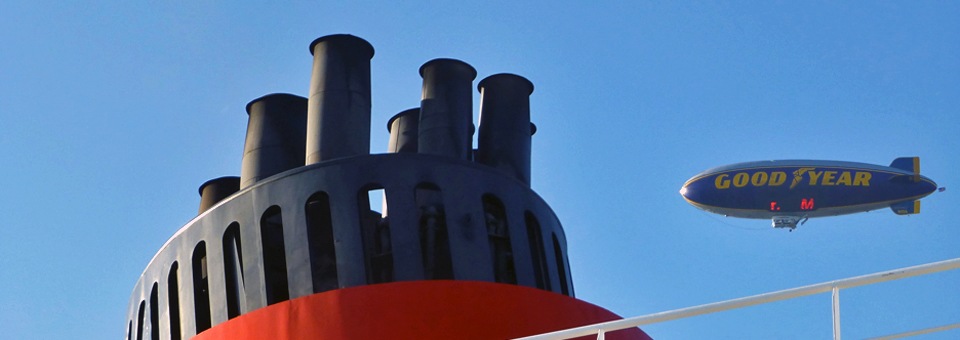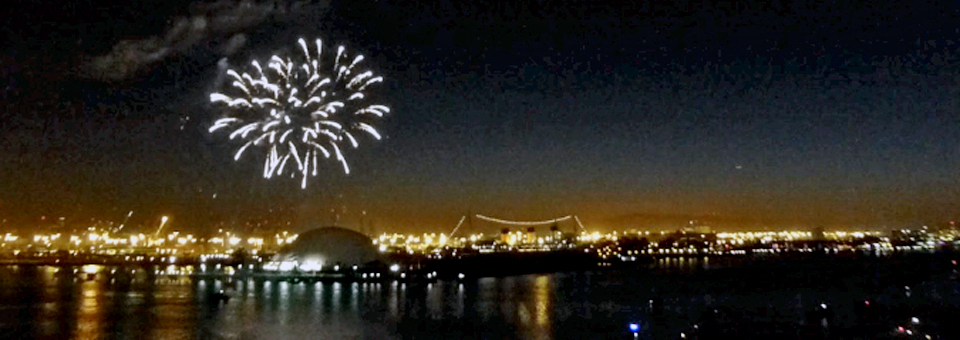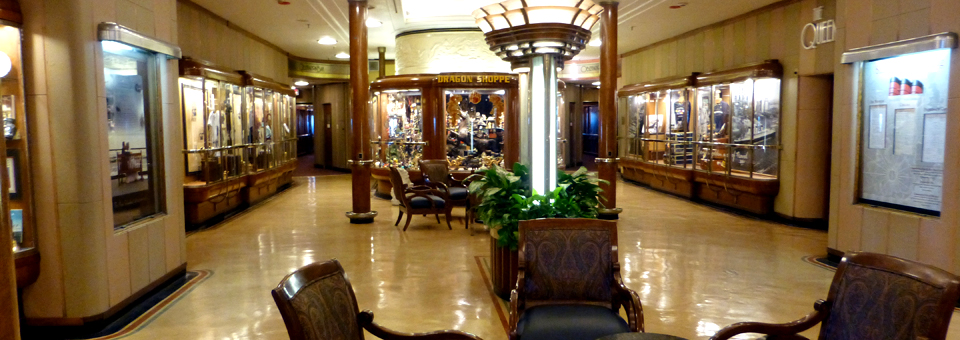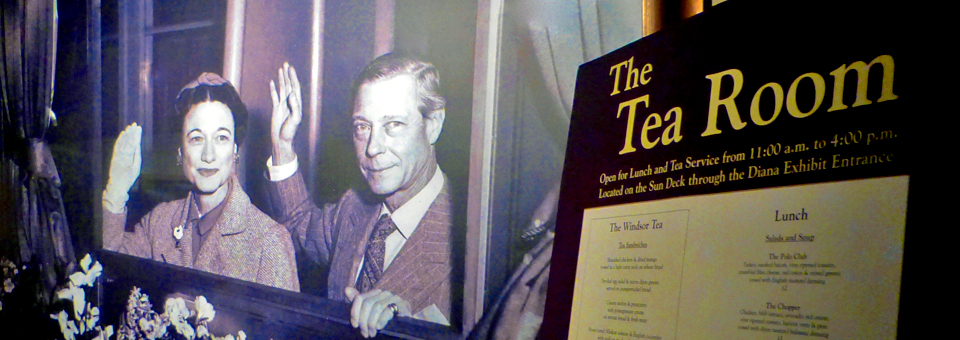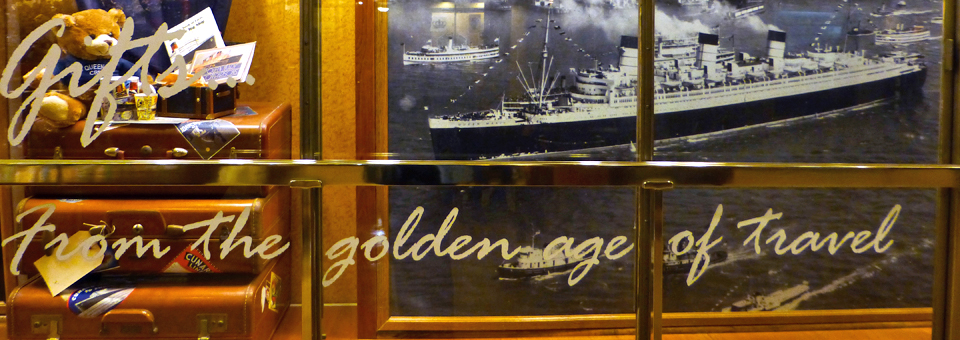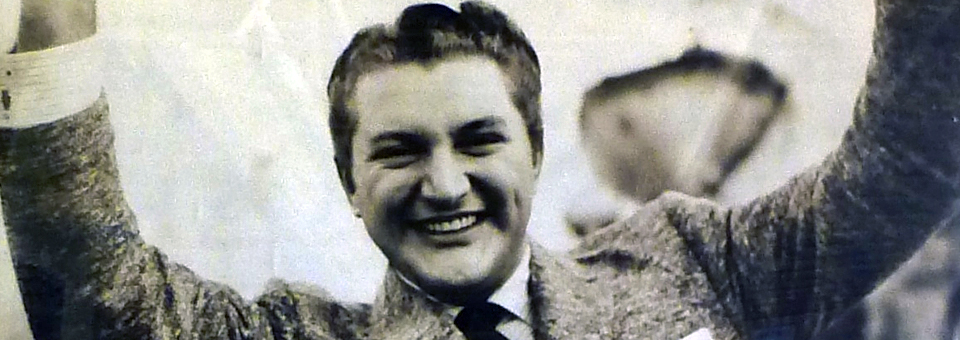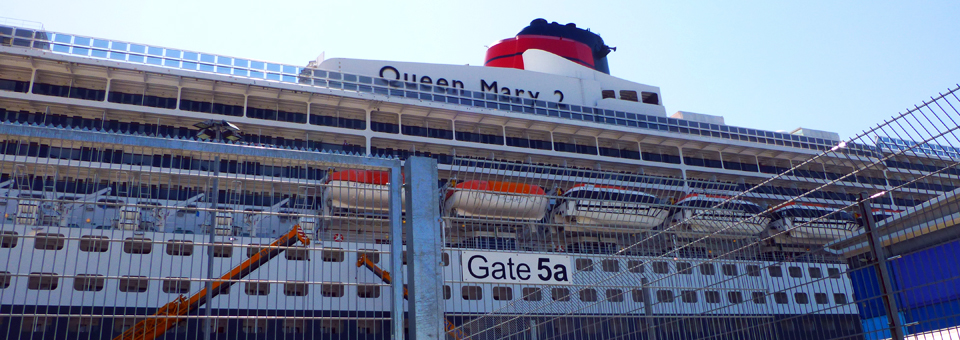The Queen Mary in Long Beach, California
When we needed a place to stay in the Los Angeles area before our Panama Canal cruise aboard Cunard’s newest ship, the Queen Elizabeth, we thought of Cunard’s legendary Queen Mary. She has been a floating hotel steeped in history and docked in Long Beach, California since ending her transatlantic runs in 1967.
Who could resist the opportunity to stay in a unique former First Class stateroom or a suite named for its famous inhabitants?
It’s a chance to walk in the footsteps of the rich and famous passengers whose photographs line the hallways.
Although modern comforts and conveniences like the king size beds and flat screen televisions have been added to the guest rooms, nonoperational original features are reminders of the vintage ship’s heritage.
There are faucets for hot and cold salt and fresh bath water from times when salt water baths were considered therapeutic. The round air vents provided climate control with warm air from the boiler room or cool air from the sea.
However, be aware that without the sounds of the engines that powered this ship, sounds pass easily through the steel walls between staterooms. Ear plugs are available at the Purser’s Desk.
Little round holes in bedside shelves kept a Bakelite water thermos and drinking glass in place. Some rooms still have the metal bars that secured steamer trunks to the walls.
A special event was underway and we were unable to get a reservation at the five-star Sir Winston restaurant. Instead we enjoyed traditional favorites at the newly renovated Chelsea Chowder House.
There’s a Sunday Champagne Brunch in the elegant Grand Salon, originally the First-Class Dining Room, and a breakfast buffet at the Promenade Café. Snacks or light fare were available just outside the Café, and tea is served from 11-4 in the tearoom.
With the morning free, we took Long Beach’s complimentary Passport shuttle that runs from the Queen Mary parking lot to the downtown area every 15 minutes. The Aquarium of the Pacific is one of the best in America, and our visit was topped off by meeting divers and feeding fish during the Behind the Scenes Tour.
If we had another day we would have taken the seasonal AquaBus that connects Long Beach Aquarium with the Catalina Express. It’s great fun to watch for whales and dolphin on the way to Catalina Island.
But we were there to get to know the Queen Mary, and returned for the Self-Guided Shipwalk, which took us throughout the ship, from the engine room to wheelhouse.
Combination tickets are available for those who have time for the variety of tours, from The Glory Days to Haunted Encounters.
We spent the rest of the afternoon at the Diana, Legacy of a Princess exhibit. Although the highlight is the collection of gowns and dresses donated to charity by Princess Diana just before her tragic death, it was the abundance of Windsor family royal artifacts that kept us there for hours — things like handwritten letters and memorabilia surrounding Queen Mary’s son Edward VIII’s abdication, including Wallis Simpson’s hot pink lingerie. It was an entertaining lesson in British history. Photos are not allowed.
The next day we headed for our cruise ship, the Queen Elizabeth. As luck would have it, the first night of our cruise was special for both ships. On September 25, 1967, as the Queen Mary was about to make her final transatlantic voyage en route to Long Beach, she passed her sister ship, the original Queen Elizabeth. Their captains stood on deck while the ships’ horns sounded.
Our sailing was a special one. In a Royal Rendezvous, the namesake Queen Elizabeth stopped to pay tribute to the legendary Queen Mary. It had been forty-five years since these two regal names crossed paths. This time, the Goodyear blimp circled above, sending congratulatory electronic messages and photographing the festivities.
Crowds cheered, bands played from the shore and the ships’ horns blared salutes. Camera flashes sparkled like diamonds, and the sky and sea were ablaze with the colors of dazzling fireworks.
The Queen Mary
Samuel Cunard of Nova Scotia began a transatlantic steamship route between Liverpool and North America with the RMS Britannia in 1840 after winning the bid for transporting Royal Mail. With the motto “We never lost a life”, Cunard ships were known for safe and reliable service and held the coveted Blue Riband for crossing the Atlantic in record time.
Cunard’s company went on to build ocean liners, including the Mauretania and the Lusitania, which was torpedoed by a German U-boat. Before long, grander ships like the French Normandie and the Italian Rex were built. The Normandie’s opulent decor included a larger version of the dining room at Versailles that also served as a grand ballroom. The Italian Rex had exquisite mosaics and murals and was known as “the Riviera afloat”. She topped Cunard’s speed record and won the Blue Riband.
Not to be outdone, Cunard began to build an even better luxury liner. Then the impact of the Great Depression of 1929 and United States immigration quotas put construction on hold.
Hoping to regain the Blue Riband and boost the economy, the British government stepped in. They offered to fund two ships for weekly transatlantic service if Cunard merged with the struggling White Star Line, a company renowned for its service but best remembered for its Titanic.
The first of the new ships was to be called the Queen Victoria in keeping with the names of earlier ships. When King George was approached about naming the ship for England’s greatest Queen, he said his wife would be delighted. She became the Queen Mary.
The Art Deco decor exuded British understated elegance. No expense was spared for this “Ship of Beautiful Woods”. Fifty-six varieties of rare and precious wood and veneers from throughout the British Empire were used, from the polished wall panels to the statuary.
Christened by Her Majesty Queen Mary after a speech by the King, she was toured by King Edward VIII, Queen Mary, Princess Elizabeth, the Duke and Duchess of York, the Duke and Duchess of Kent, and the Duchess of Gloucester before her first journey.
The First Class passenger list for her sold-out maiden voyage in 1936 included aristocrats, industrialists, statesmen, and stars of stage and film. Six thousand onboard visitors left minutes before she sailed to “Rule Britannia.” King Edward VIII wired a congratulatory message. Airplanes buzzed overhead and boats sounded horns. More fanfare awaited in New York.
The Queen Mary captured the Blue Riband that year, crossing the Atlantic in three days, twenty-one hours, and forty-two minutes. The Normandie won it back seven months later, but he Queen Mary regained it in 1938 and held it until the American SS United States topped her record in 1952.
Queen Elizabeth, the Duke and Duchess of Windsor, Fred Astaire, Great Garbo, Lynn Redgrave, Liberace, Clark Gable, Audrey Hepburn, and General Dwight Eisenhower and Elizabeth Taylor were but a few of her renowned passengers.
Sir Winston Churchill and his wife, Clementine, made six voyages aboard the Queen Mary . He signed papers finalizing the D-Day Invasion of Normandy in the First-Class Drawing Room on the Promenade Deck.
The Queen Mary was repainted for war service and called the Grey Ghost for her color and speedy secret runs. Winston Churchill crossed under the code name Colonel Warden for conferences in the United States and Canada. Bing Crosby, Bob Hope and Fred Astaire cruised to entertain the troops.
The Queen Elizabeth
The second ship, the luxurious Queen Elizabeth, was built with many improvements and refinements for Cunard’s 1940 centennial, but before her engines could be tested for passenger service she was painted battleship gray and secretly diverted to New York. Her home port, Southampton, was bombed on the day of her intended arrival.
She joined the Queen Mary and the Normandie, already in New York. Fire destroyed the Normandie before she could be put into military service.
Since the Queen Elizabeth and Queen Mary could cross the Atlantic at speeds high enough to outrun World War 2 German U-boats, they were armed and used to transport troops. Although she never encountered enemy action, the Queen Mary collided with her escort ship, the Curaçao in October, 1942, cutting it in half. With strict orders never to stop, she continued on, leaving other ships to rescue survivors.
Churchill said that using the Queens to bring American troops to Britain shortened the war by at least a year. The Queen Mary still holds the record for transporting the most troops–16,082–in a single voyage. She served as a post-war hospital ship and transported 22,000 war brides and children to the United States and Canada.
A new world of cruising
Rich and famous first class cruisers of the late 1950s became a jet set who crossed the ocean in hours, not days. Airfares soon became affordable to middle class passengers, as well.
That, together with soaring fuel and labor costs, meant the next Cunard ship, the Queen Elizabeth 2, or QE2, had to operate more economically and with more versatility. She was launched in the 1960s as a dual class express transatlantic liner in the warmer seasons and luxurious cruise ship the rest of the year.
Her beams were sized to pass through the Panama Canal and drafts made suitable for ports on her annual world cruise. The flagship QE2 was in service for forty years, bridging the gap between the classic ocean liners and today’s Queens.
The fate of the Speed Queens
The Queen Mary was the first to be retired. Too large to go through the Panama Canal, she traveled from Southampton around Cape Horn to Long Beach. The 14, 500 miles was her longest peacetime journey.
The Queen Elizabeth, also too big for the Panama Canal or Caribbean ports, was purchased by a Hong Kong businessman for use as a floating university. She was destroyed by a mysterious fire in Hong Kong harbor and become the largest passenger shipwreck. The wreck was featured in the James Bond movie The Man with the Golden Gun.
In 2008 the QE2 was sold to become a luxury hotel in Dubai. Its future remains uncertain.
The Newest Ships
The heritage and traditions of Cunard’s Golden Age of cruising lives on with one of the youngest fleets at sea–the flagship Queen Mary 2, the Queen Victoria, and the Queen Elizabeth, which we took us through the Panama Canal.

